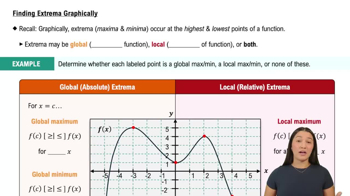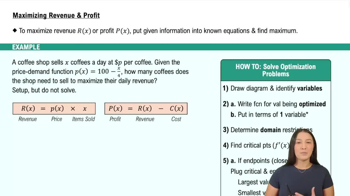Table of contents
- 0. Functions7h 52m
- Introduction to Functions16m
- Piecewise Functions10m
- Properties of Functions9m
- Common Functions1h 8m
- Transformations5m
- Combining Functions27m
- Exponent rules32m
- Exponential Functions28m
- Logarithmic Functions24m
- Properties of Logarithms34m
- Exponential & Logarithmic Equations35m
- Introduction to Trigonometric Functions38m
- Graphs of Trigonometric Functions44m
- Trigonometric Identities47m
- Inverse Trigonometric Functions48m
- 1. Limits and Continuity2h 2m
- 2. Intro to Derivatives1h 33m
- 3. Techniques of Differentiation3h 18m
- 4. Applications of Derivatives2h 38m
- 5. Graphical Applications of Derivatives6h 2m
- 6. Derivatives of Inverse, Exponential, & Logarithmic Functions2h 37m
- 7. Antiderivatives & Indefinite Integrals1h 26m
- 8. Definite Integrals4h 44m
- 9. Graphical Applications of Integrals2h 27m
- 10. Physics Applications of Integrals 2h 22m
5. Graphical Applications of Derivatives
Applied Optimization
Problem 4.8.37d
Textbook Question
{Use of Tech} A damped oscillator The displacement of an object as it bounces vertically up and down on a spring is given by y(t) = 2.5e⁻ᵗ cos 2t, where the initial displacement is y(0) = 2.5 and y = 0 corresponds to the rest position (see figure). <IMAGE>
d. Find the time and the displacement when the object reaches its high point for the second time.
 Verified step by step guidance
Verified step by step guidance1
Identify the function for displacement: y(t) = 2.5e^(-t) * cos(2t). This function represents a damped harmonic oscillator, where the exponential term 2.5e^(-t) accounts for the damping effect, and cos(2t) represents the oscillatory motion.
To find the high points, we need to determine when the derivative of y(t) with respect to t is zero. This involves finding y'(t) and setting it equal to zero. Use the product rule for differentiation: if u(t) = 2.5e^(-t) and v(t) = cos(2t), then y(t) = u(t)v(t) and y'(t) = u'(t)v(t) + u(t)v'(t).
Calculate the derivatives: u'(t) = -2.5e^(-t) (derivative of 2.5e^(-t)) and v'(t) = -2sin(2t) (derivative of cos(2t)). Substitute these into the product rule formula to find y'(t).
Set y'(t) = 0 to find the critical points. This will give you an equation involving trigonometric and exponential terms. Solve this equation to find the values of t where the displacement reaches a high point.
Determine the second high point by identifying the second positive value of t from the solutions obtained. Substitute this value back into the original displacement function y(t) to find the corresponding displacement at this time.
 Verified video answer for a similar problem:
Verified video answer for a similar problem:This video solution was recommended by our tutors as helpful for the problem above
Video duration:
5mPlay a video:
Was this helpful?
Key Concepts
Here are the essential concepts you must grasp in order to answer the question correctly.
Damped Oscillator
A damped oscillator is a system in which the amplitude of oscillation decreases over time due to a resistive force, such as friction or air resistance. In the given equation, the term 'e⁻ᵗ' represents the damping effect, causing the oscillation to gradually lose energy and amplitude as time progresses.
Recommended video:

Cases Where Limits Do Not Exist
Cosine Function in Oscillations
The cosine function is fundamental in describing periodic motion, such as oscillations. In the equation y(t) = 2.5e⁻ᵗ cos 2t, the 'cos 2t' component indicates that the object oscillates with a frequency determined by the coefficient of 't', which affects how quickly the object moves up and down.
Recommended video:

Graph of Sine and Cosine Function
Finding Extrema in Functions
To find the high points (maxima) of the oscillation, one must analyze the function y(t) for critical points. This involves taking the derivative of y(t), setting it to zero, and solving for t to determine when the displacement reaches its maximum value, which corresponds to the high points of the oscillation.
Recommended video:

Finding Extrema Graphically

 1:13m
1:13mWatch next
Master Intro to Applied Optimization: Maximizing Area with a bite sized video explanation from Callie
Start learningRelated Videos
Related Practice









